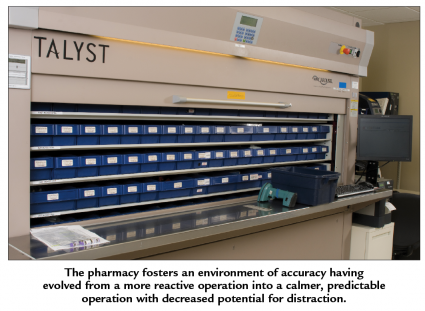- Show Menu
- Contact Us
- FAQs
- Reader Service
- Survey Data
- Survey Winners
- Testimonials
- Upcoming Events
- Webinars
- White Papers
AutoCarousel from Talyst
Lancaster General Health (LG Health) is a 640-bed not-for-profit health system encompassing Lancaster General Hospital (LGH) and Women & Babies Hospital. Outpatient, express, and urgent care services are also provided.
Over the past five years, LGH, which dispenses about 10,000 doses of medication daily, has implemented several improvements to its medication-use process. Improvements to our medication management model included a decentralized, cartless approach to medication distribution; bar code-enabled medication administration; tighter inventory control; and utilization of direct observation methodology.
Formerly, the dispensing process within the LGH pharmacy was not highly standardized. Medications were stored in multiple locations and technicians refilled medications based on specific automated dispensing cabinet (ADC) refill reports. Each shift, technicians followed a fairly ad hoc process to pick and fill orders. This required multiple fill processes throughout the day and at times resulted in many critical lows and stock-outs.
Inventory Management
In early 2006, the pharmacy sought to improve its medication dispensing process by implementing Talyst’s AutoCarousel. With this system, bar code and “pick to light” technology is leveraged to increase the accuracy and efficiency of picking and restocking. This process is controlled by Talyst’s AutoPharm software, a workflow application that manages all medications physically stored in the AutoCarousel, as well as those stored in other locations in the pharmacy, such as the refrigerator or on static shelves. Software compatibility between AutoPharm and LGH’s ADC system allowed medication loads and refills to be transmitted seamlessly, providing better visibility into our supply chain process.
Improving Efficiency
Implementing this automation process led to improved efficiency in the pharmacy. Effectively, pharmacy’s turnaround time was cut significantly through decreased fill and check times and improved workflow and medication management, since medications are readily available when needed at the point of administration. Also, because medication inventory is consolidated, inventory levels can be dramatically reduced. As a result of a physical space re-design to address our undersized pharmacy and comply with USP Chapter <797>, main medication storage was centralized to a single location. This greatly reduced the number of medication storage areas to maintain.
Standardizing Processes to Decrease Errors
A standardized, twice daily ADC pick and fill process enables pharmacists and technicians to focus their full attention on these activities, compared to the continuous, ad hoc replenishment processes previously in place. Due to the increased focus and isolation of the new distribution process, as well as decreased stock-outs, pharmacists experience improved attention to detail, especially during critical prospective order review.

With the carousel implementation, we have minimized the opportunity for errors in several ways:
- Personnel involved in the pick and fill process are much less distracted and experience far fewer interruptions
- The medication package is bar-code verified during dispensing upon removal from the carousel
- Pharmacists are more actively involved in the checking process, as they must physically place each medication in a bag rather than simply inspect medications gathered by the technicians
- All dispensed medications are first scanned in the pharmacy and any labels that cannot be scanned are fixed prior to delivery to the nursing units, thus increasing nursing’s scanning compliance
Technology Continuum
When evaluating carousel options, consider as many abstractly affected concepts as possible, such as workflow fit and software criteria, rather than just reviewing the tangible hardware components of unit weight, footprint, and price. Pay particular attention to the potential interfaces between the carousel, the pharmacy system, and the ADCs. In addition, review whether the carousel can support your existing technology, such as a high-speed oral solid packager or a bar code labeling application. Our integrated system enables the electronic aggregation of all needed medications, so technicians only have to visit the appropriate bin for each medication line item once per pick session. Labels representing all medications to be picked are printed from AutoPharm, and the labels form a consistent representation throughout the medication dispensing process. The combination of AutoPharm software and the carousel technology enables pharmacies to pick and fill exactly what is needed to fulfill replenishment orders.
Conclusion
Before implementing our carousel system, our pharmacy technicians had to meet daily to devise a plan for filling that day’s medication orders. This process lacked standardization and continuity of care, and resulted in inconsistent assignments for the nursing units. Now, the pharmacy fosters an environment of accuracy having evolved from a more reactive operation into a calmer, predictable operation with decreased potential for distraction. Enhanced patient safety, a more standardized medication distribution process, greater workflow efficiency, and a simplified learning curve for new personnel are just a few of the benefits we have seen to date directly related to our carousel technology. The introduction and use of this technology has allowed our pharmacists to be deployed into more clinical roles allowing us to achieve best practices in medication safety and drug therapy management. Keith A. Renner MBA, RPh, is the director of pharmacy operations at Lancaster General Health in Lancaster, Pennsylvania. A graduate of the Massachusetts College of Pharmacy and DeSales University, Keith has been a practicing hospital pharmacist for over 17 years.
Keith A. Renner MBA, RPh, is the director of pharmacy operations at Lancaster General Health in Lancaster, Pennsylvania. A graduate of the Massachusetts College of Pharmacy and DeSales University, Keith has been a practicing hospital pharmacist for over 17 years.
Like what you've read? Please log in or create a free account to enjoy more of what www.pppmag.com has to offer.








